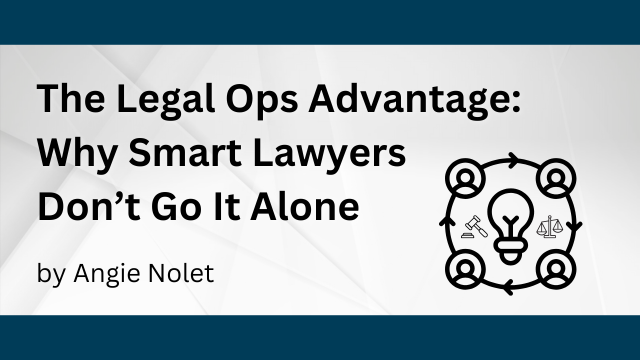
[EDRM Editor’s Note: The opinions and positions are those of Angie Nolet.]
Picture this: you’re in-house counsel, and your company’s just been sued. But you’ve seen this film before. You know (with reasonable certainty) how much it’ll cost to get from complaint to Rule 26, through discovery, motions practice, and even trial. Why? Because you’re armed with data.
You’ve got a data map, so you know where the bodies (and documents) are buried—what exists, where it lives, and how long it’ll take to wrangle. But that’s just the start—table stakes, if you will. You also know what similar matters—same claims, same jurisdiction, maybe even the same judge—have cost in the past. And not in a vibes-based, gut-check way. In a metrics-driven, dashboard-powered way that lets you own your strategy and defend your spend.
Because you’ve teamed up with legal ops to capture and mine this intel, you’ve decoded your cost curve. You can spot the tipping point—the moment when settlement is a savvy move, or when trial shifts from a risk to a power play. That clarity lets you make smarter, faster, and more defensible calls. Not everyone operates like this. But some do.
And those lawyers? They’re unicorns.
Building this data-driven dreamworld is not only possible—it’s how you cement your value. It’ll look different across orgs, but if you’re game to build your own data Eden, here’s how to get started:
1. Embrace the shift: run legal like the business it is.
This doesn’t mean your work is unimportant. Far from it: your work is crucial. But—and here’s the key—so is legal ops’s work. Their focus is different, yes, but no less valuable. To partner effectively, lawyers must see legal ops not as support staff, but as strategic co-pilots driving how legal delivers value across the enterprise.
Legal ops drives cross-functional alignment—syncing legal with finance, IT, HR, and compliance. They make legal feel less like a silo and more like a business unit. Their PM chops equip them to orchestrate complex rollouts, whether that’s litigation readiness, tech implementation, or a global regulatory overhaul. Lawyers must evolve beyond a request-and-support mindset and instead build joint strategies—especially when the project’s success hinges on cross-departmental coordination or scalable systems. Lawyers bring the law; legal ops brings the how-to.
Pro tip: Loop in legal ops early—before whiteboarding, before kickoff. They’ll connect the dots and grease the wheels.
To partner effectively, lawyers must see legal ops not as support staff, but as strategic co-pilots driving how legal delivers value across the enterprise.
Angie Nolet.
2. Align on outcomes—then own them together.
Define success as a team. Legal ops brings budgeting, forecasting, and financial discipline; legal brings risk mitigation and strategic judgment. Together, you can build a shared scorecard—tracking matter cycle time, budget accuracy, and issue resolution. If you engage early, you can shape what matters gets measured—and ensure legal risk is balanced against business need.
Pro tip: During matter intake, co-create KPIs and checkpoints. Don’t just plan the work—track it together.
3. Talk early. Talk often. Talk like teammates.
The best partnerships are built on honest, frequent, and respectful communication. Legal ops can help scale that—through internal comms, change management, and knowledge hubs. They’re often the architects behind intranet portals, playbooks, and dashboards that keep teams aligned and informed. If you engage consistently, you can help tailor these tools to how legal actually works.
Pro tip: Ditch the “quarterly sync” model—check in regularly, share insights, surface friction points, and shape the rhythm together.
4. Tap legal ops for what they do best: tech and process.
Legal ops professionals are the department’s technologists and process architects. If you want to work smarter, not harder, this is your go-to partner. From eBilling and matter management to CLM and AI contract review, legal ops leads tech selection, rollout, and adoption. They also optimize workflows, applying lean and agile methods to eliminate bloat and cut turnaround time.
Got pain points? Legal ops has solutions—and the data to prove what works.
Pro tip: Don’t just say “this is frustrating”—spell out your blockers, and invite legal ops to prototype fixes.
5. Manage outside counsel as a united front.
Legal ops handles the numbers. Lawyers handle the narrative. Together, you manage the relationship. Legal ops leads vendor onboarding, spend tracking, billing compliance, and RFPs. They maintain firm dashboards and track performance. You bring the qualitative lens—what good work looks like, when to escalate, and when it’s time for a change.
Pro tip: After a major matter, give meaningful feedback—on results, responsiveness, efficiency, and fit. Don’t keep that intel to yourself.
6. Empower legal ops and respect their profession.
Legal ops is booming—and professionalizing. With backgrounds in consulting, finance, systems, and certifications like PMP and Lean Six Sigma, these pros are building next-gen legal departments. They lead org design, create development tracks, and train teams across functions.
Lawyers who recognize and elevate legal ops aren’t just better partners—they’re building stronger, more inclusive departments.
Pro tip: Back legal ops at the leadership table. Nominate them for awards. Ask their opinion—not just on process, but purpose.
Lawyers who recognize and elevate legal ops aren’t just better partners—they’re building stronger, more inclusive departments.
Angie Nolet.
Want to be the kind of in-house lawyer who makes smarter calls, drives stronger partnerships, and future-proofs your department?
Start with legal ops.
Assisted by GAI and LLM Technologies per EDRM GAI and LLM Policy.


